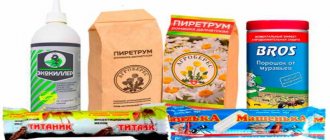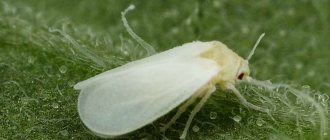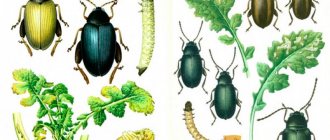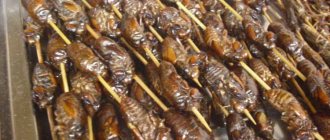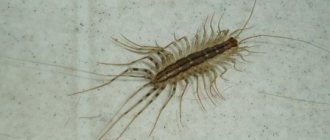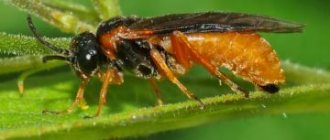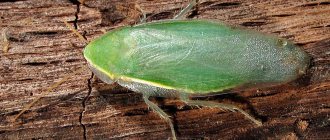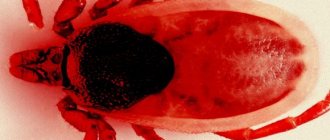The gall mite is a parasitic insect that lives on trees and feeds on the leaf sap of pear trees. The insect is able to move independently from tree to tree. If the tree is heavily infested, the pest provokes drying of the leaves, disruption of the photosynthesis processes of the pear, slower growth of fruits, and a decrease in yield. In this material we will look at how to determine the appearance of a gall mite on a pear, for what reasons it occurs, how to deal with it using agrotechnical, chemical or folk methods, as well as what preventive recommendations should be followed to protect trees from the pest.
Signs of occurrence and causes of occurrence
It is impossible to notice an insect on a tree with the naked eye due to its small size - up to 0.2 mm. Infection of a plant by a parasite is indicated by the formation of underdeveloped shoots on the tree, as well as the appearance of yellow-brown and darkening swellings on the leaves - galls. Galls may also clump together into large tumor-like formations. Over time, these formations dry out and crack, after which the insects move to neighboring sheets. Also learn how to grow green onions at home in this article.
They contain both adult insects and larvae laid by females.
Pests move from plant to plant on their own. They overwinter in the old bark, in the buds. In the spring, when the temperature rises to 10 degrees, females lay up to 6 eggs in the buds even before they open.
Factors contributing to the infestation of an area with parasites are thickening of the crowns, lack of sanitary pruning, excess phosphorus fertilizers, as well as the accumulation of a large number of old leaves and fruits on the ground. Treatment of the area with insecticides, which are harmless to the parasite itself, but destroy its natural enemies, for example, dragonflies, helps to increase the number of ticks. This material will tell you about the characteristics and planting of leeks.
In some cases, insect fertility is increased by drugs used to increase pear productivity. For this reason, they are recommended to be used only after preventive treatment of the garden with chemicals or folk remedies against ticks.
Methods for controlling pear gall mites
It should be remembered: the gall mite is not an insect, but an arachnid. Therefore, conventional broad-spectrum insecticides are useless in combating them.
Chemicals for spraying in early spring
This is the most effective method in pest control, giving the fastest results. But keep in mind that the pest quickly develops immunity to any drugs; after 2-3 treatments, the product must be changed.
Do not forget about safety measures, use personal protective equipment (goggles, respirator, gloves, hat, thick clothing that completely covers your arms and legs). Strictly follow the instructions regarding the concentration of the drug in the solution and the frequency of treatments.
When treating the garden with any chemicals, even if they are positioned by the manufacturer as safe for humans, take care to protect the skin and mucous membranes
For the procedure, choose a cloudy, windless day. The algorithm is as follows:
Prepare a working solution (it cannot be stored). Pour the product into a container with a spray bottle. Treat the tree and the soil underneath as thoroughly as possible, paying special attention to the buds.
For prevention, spraying is carried out in early spring, before the buds have yet opened, at the time of ovary formation and in mid-autumn. To combat gall mites, 3–5 applications with an interval of at least 10 days are usually sufficient. It is not advisable to treat the tree 20–25 days before harvest, unless the preparation is safe for human health and the environment.
- Apollo. Contact pesticide based on pyrethroids. Destroys adult gall mites, larvae and eggs without harming beneficial fauna.
Apollo is a “selective” acaricide that kills gall mites but does not harm beneficial insects
It is not advisable to use the drug Karate Zeon if there is an apiary somewhere nearby
The drug Fufanon helps to get rid of many garden pests at the same time
A relatively new method of combating gall mites is injections. Microdoses of chemicals containing sulfur and phosphorus are introduced directly into the sap flow system. The procedure requires professional skills and equipment. They don’t do it on their own, inviting specialists from gardening centers. Injections are carried out at the same frequency as preventive chemical treatments.
Only a specialist can give a correct “injection” to a fruit tree.
Preparations of biological origin
A significant advantage of such preparations is environmental safety and the ability to carry out treatments at any time. They are less effective than chemicals and help cope with gall mites if the problem is noticed at an early stage:
- Vertimek. A means of enteric contact action, the active substance is processed waste products of fungi. The effectiveness of the drug increases in the heat. The harvest can be harvested within 3 days after treatment.
The higher the air temperature after treatment, the more effective the drug Vertimek
Fitoverm is one of the most popular biologically derived pest control products among gardeners.
Video: instructions for use of the drug Fitoverm
Folk remedies for spring and summer treatments
Traditional methods of combating gall mites in case of mass infestation are useless. They are practiced mainly by adherents of natural agriculture on absolutely healthy trees. Folk remedies do not provide a complete guarantee of protection against pests. They are valid for 10–15 days (or until the first rain). To make the composition “stick” to the leaves better, add fine soap shavings (15–20 g per 10 l):
- Dandelion infusion - chop 1 kg of fresh leaves, add 3 liters of warm water, let it brew in a dark place for 3 days. Strain before use.
Dandelion isn't just a pesky weed; it can be used to prepare “green fertilizer” and an infusion to protect fruit trees from gall mites
Calendula is not only an ornamental, but also a very useful plant.
Potato tops for preparing the infusion must be absolutely healthy, otherwise there is a risk of spreading the infection throughout the garden
Hot chili peppers are not to the liking of many pests
The shelf life of ready-made formulations is no more than a day. Treatment is carried out only in cloudy weather.
Treatment
Even with a severe infestation of pears, a gardener can quickly get rid of gall mites.
To combat parasites, he can use agrotechnical methods, as well as treating trees with chemicals and folk remedies.
The choice of a specific pest control product depends on the degree of infestation of the garden and the period when the mite was noticed (before the flowers appear or after the start of flowering). The greatest effectiveness in combating the parasite is provided by a combination of traditional methods, agricultural technology and chemicals, as well as the alternation of various acaricides and insecticides used to treat pears. Find out about the Miracle cherry variety here.
Agrotechnical methods
If the pest population is small on the site, it can be controlled using agrotechnical methods. The following techniques give a good effect:
- Using mineral fertilizers to feed plants. They help reduce the osmotic pressure in cell sap, which makes it difficult for ticks to feed.
- Whitewashing of trees, regular removal of old bark from the trunk and large branches. This reduces the number of parasites.
- Removing weeds from the site, old leaves and fruits. This reduces the risk of pests appearing in your area and prevents their further reproduction.
The measures presented can reduce the number of pests in your garden, but cannot always completely get rid of them. In case of severe infection of plants, it is better to use chemicals.
Chemical methods
You can quickly get rid of gall mites using chemicals containing organophosphorus compounds or chlorine: Karbofos, Akrex, Fufanon, Nitrafen.
These drugs attack the parasite's digestive system, causing it to die.
Spraying with such preparations should be carried out once every two weeks.
If a gardener suspects that a mite may have overwintered in a tree, he can treat the plant with Inta-vir even before the sap begins to move along the trunk. This product is diluted in the proportions of 1 tablet per bucket of water, and then the resulting solution is used to treat the garden. After harvesting, spraying with the drug is carried out again.
Find out about the features of care and rules for planting Gherkin cucumbers at this link.
The gardener needs to alternate treating the tree with different types of chemicals. Otherwise, the tick will be able to develop immunity to them, and the products will lose their effectiveness.
During fruit growth, spraying against mites should not be used - this may affect the quality of the crop. In this case, it is better to use injections of acaricides or insecticides. Since such procedures need to be carried out using special equipment, it is advisable to call a special service that fights parasites.
Traditional methods
You can also fight the pest using folk remedies. They can be used during the flowering period of such varieties as Pamyat Zhegalova, Bere, Avgustovskaya, and before harvesting - they will not affect the quality of the fruit. The most effective anti-tick remedies are:
- Dandelion infusion. To prepare it, you need to take a kilogram of dandelion leaves, add 3 liters of water and leave to infuse for 3 days. Next, you will need to decant the product, add two tablespoons of liquid soap to it, and then spray the trees with it.
- Potato infusion. To do this, you need to take a kilogram of potato tops, chop them, and then pour a bucket of warm water. The resulting mixture should be left to infuse for 4 hours. After this, you need to strain the resulting infusion through cheesecloth and pour in a tablespoon of any liquid soap. On the same day, you will need to treat the garden with the mixture.
- Infusion of marigolds. For this remedy, you will need to take 100 grams of flowers, add a liter of water and boil. The decoction should be left to infuse for 5 days. After this, another liter of water is poured into it and used to spray infected pears. In a similar way, you can prepare a chamomile infusion for garden treatment.
Find out about the use of onion peels for gardening here.
Treatment of trees with the presented infusions can be carried out early in the morning, in the evening or during the day in cloudy weather (but not before rain, as it will wash the product off the tree). If you carry out this treatment on a clear day, drops of infusion under the bright sun will burn the leaves.
The danger of pear gall mite
The gall mite is dangerous in the sense that because of it, new shoots slow down their growth, it spoils the buds, ovaries, and buds. Because the buds are damaged, changes occur in the leaves and photosynthesis is disrupted. The ovaries turn out ugly, fall off prematurely or do not form at all. Infectious agents easily penetrate through the punctures they leave. The tree begins to lack nutrients.
If a gall mite is detected on a pear, control measures must be taken immediately, otherwise the crop losses will be colossal - up to 95%. And young seedlings can quickly die from a massive pest invasion.
Prevention
To prevent gall mites from appearing on your site, you must follow simple preventive measures. They provide:
- Strict adherence to the dosage of fertilizing. It should be remembered that excess phosphorus promotes the proliferation of gall mites, therefore this type of fertilizer should be used in minimal quantities on the site.
- Preventive treatment of the area with Karbofos, Fufanon and other similar chemicals. It can be carried out once a month if cases of pest damage to plants have been recorded in a neighboring area.
- Implementation of general agrotechnical recommendations for caring for pears, including timely thinning of the crown, removal of dead bark, whitening of trunks, removal of old leaves from the site, removal of weeds. These measures help reduce the number of gall larvae on the site.
Also, in order to prevent the appearance of ticks, you can use hunting belts made of corrugated paper or burlap. They are effective against most pests that are dangerous to fruit trees.
What measures exist to combat mites on pears?
You need to fight the gall mite on a pear immediately at the first signs of damage. There are different ways:
- agrotechnical;
- using bio- and chemical preparations;
- folk ways.
One of the effective measures is agricultural technology. Namely:
- You need to purchase cuttings and seedlings from trusted sellers so that they are not infected.
- Do not leave fallen leaves and carrion on the site, in which pests can overwinter.
- Autumn digging of the root surface of trees helps fight pear mites.
- Feeding pears with wood ash strengthens the plant's immunity.
- When purchasing, pay attention to pest-resistant varieties, especially since today this is not a problem.
It is necessary to apply measures to combat mites on pears from early spring and throughout the summer season:
- Before the buds bloom, treat the pear trees with Decis or Inta-vir.
- It is recommended to spray buds starting to bloom with a solution of Karbofos and Isofen.
- When flowering ends, you can fight the pear mite using colloidal sulfur. The air temperature should be +20 degrees and above. If the lesion is severe, treatment alone is not enough. You will have to repeat them in June and July every 10 days.
There are different ways to combat parasites, but the choice depends on the gardener and the pest breeding activity.
conclusions
- The gall mite is a parasitic insect that settles on pear leaves and feeds on their juice. It moves from one pear to another on its own. Severe infestation by the pest leads to a decrease in the yield of the tree.
- Factors contributing to the infection of any varieties of pears, such as Bergamot and Moskvichka, are violation of agricultural technology recommendations, lack of crown pruning, and abuse of phosphorus fertilizers.
- To combat insects, you can use chemicals, including Karbofos, folk remedies, as well as some agricultural techniques. They allow you to get rid of the parasite in several treatments.
- For prevention purposes, it is recommended to periodically treat the area with acaricides, use fishing belts made of burlap or corrugated paper, and also reduce the use of fertilizers with a high phosphorus content.
Description of the pest
The gall mite, which lives on pears, belongs to the sucking species of insects. It cannot be seen with the naked eye, since the body of the pest reaches a maximum size of 0.3 mm. Using a sharp proboscis, it makes holes in the leaf and sucks out the cell juices from it. The mite can live everywhere where pears are grown.
In winter, mite larvae take refuge under the scales of leaf buds, and with the onset of heat, they suck out the juice from them, as a result of which the bud dies. During the same period, females lay eggs, and the larvae that grow from them continue to suck sap from the tree. In one season, 3-5 new generations of ticks grow.
Description of the insect
In spring and throughout the summer, the body of the gall mite remains white, and by autumn it changes color to pinkish with a brown tint. There are 2 pairs of legs near the head. At their expense, movement is ensured. The body of the mite looks like a worm - this can be seen in the photo of the gall mite.
The insect settles in various gardens, parasitizes many trees, but most often occupies pears, and then moves on to other crops. The absence of a pest in early spring does not guarantee that it will not appear later. Its spread is facilitated by other, larger insects, animals, birds and wind.
Wintering takes place in the kidneys. When the spring air warms up to 10 degrees, the active stage begins. At this time, in each still closed bud, the females lay eggs, and up to 5-6 insects emerge from them.
The clutches are always large, so the pest infests the plantings very quickly. Within a short time, entire colonies of adult individuals are formed that are capable of producing offspring. During the summer, the insect lays up to 20 eggs.
